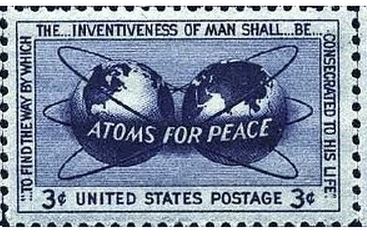The feasibility of carrying out these four orders in the absence of new funding to do the work, and with the context of major staff reductions at DOE, and anticipated staff cuts at the NRC, raises questions about the likely success of the effort, at least given current circumstances.
One industry investor emailed this blog with an enthusiastic endorsement of the executive orders. The investor wrote, “this is the boldest move since the Eisenhower administration. Even if the US achieves half the objectives of the four EOs, this will still be a transformative initiative and investment in nuclear power for America and the world. This marks the greatest support for nuclear power since Atoms for Peace.”
Is it? Maybe, but big plans require big money. If there is one thing that is axiomatic about new presidential programs is that you need to follow the money. Siting reactors at major federal installations, such as INL, ORNL, etc., will require new money for these labs, and other federal facilities, to manage the site selection and assessment processes. Further, who pays for infrastructure improvements for these nuclear projects including grid access, roads, etc.?
Will Congress agree, in a climate of seeking major cuts in federal spending, to appropriate the billions needed for building SMRs in “fleet mode” as well as multiple new full size reactors, or does the government believe that the private sector will provide the investment dollars needed for them?
Ultimately, success for the objectives in these executive orders will depend on congressional appropriations and the staffing at multiple federal agencies needed to do the work. Without money or staff the executive orders are just paper tigers.
History Lesson: Congress, the President, and GNEP
This is the story of how the ill-fated GNEP program under President George W. Bush collapsed due to congressional push back on funding. Like the current batch of executive orders, GNEP offered a vast menu of big ticket items including new reactors, a big emphasis on spent fuel reprocessing programs, and involvement of federal facilities to host them. Like GNEP the current executive orders lean heavily on the funded roles of federal facilities, civilian and defense related, to carry out these initiatives.
Congress refused to fund any of it because the White House failed to consult with the relevant members of the key authorization and appropriation subcommittees. The reason is that the executive orders issued by this White House rely heavily on federal funding for implementation but, like GNEP, there appears to have been no advanced consultation with members in either the House or Senate. Even the National Academy of Sciences reported out its view that GNEP was “too aggressive” and added there was “no economic justification” for the program.
This lack of consultation with congress is a big gap in the executive orders exercise. None of these types of people (members of key congressional committees) were at the White House rollout of the executive orders Friday 05/23/25.. When the administration comes to congress asking for funding for the big ticket items, the lack of doing the necessary missionary work will come back to haunt it.
Slow Media Day Anyone?
Why did the White House announce such a significant undertaking on a Friday afternoon, especially the Friday before the three-day Memorial Day holiday weekend? It has got to be second only to the Friday before Labor Day or the Friday after Thanksgiving.
Anyway you cut it the news is coming out in a “dead media” space at the tail end of the news cycle for the week and a kicker of it being the start of a major holiday. By noon on this Friday a good chunk of the nation has left work or has one step out the door.
Who’s paying attention? Why didn’t the White House go with a better date for the media event? How about a picking a date when Congress is in session for starters?
What is the Role of the Private Sector?
There is little or no mention of how the private sector will be engaged to implement the action items in the executive orders. For instance, aside from a brief mention of the DOE loan program, which has been shredded by layoffs, there isn’t any reference to new innovative methods of financing new SMRs and restarting shuttered nuclear plants, or otherwise reducing the risk of private investment, e.g., shielding investors from the costs of schedule delays, cost overruns, and general mismanagement like what happened at V.C. Summer.
There is not mention of making loans available to supply chain firms on a scale equal to the scope of the program initiatives in the executive orders. The SBA is not positioned to engage in a loan program that funds ramping up suppliers of long lead time items like transformers, steam generators, etc., nor is it capable of issuing export credits to international firms that will provide reactor pressure vessels, etc.
The debt issuing authorities of the relevant export finance agencies need to be addressed. At home TVA’s debt ceiling needs to be raised and the White House needs to fully populate its board so that it can make big investment commitments in SMRs and future reactors.
In the US there are just three feasible restarts of shuttered reactors and two of them are underway. These projects are Holtec’s Palisades plant in Michigan, Constellation’s TMI-1 in Pennsylvania, and, maybe NextEra’s Duane Arnold Plant in Iowa.
There is an exploratory effort to restart and complete the twin AP1000s at the V. C. Summer station in South Carolina. Some expressions of interest have reportedly come in, but financing and EPC roles will need be worked out to set that project in motion.
Fusion Missing in Action?
There is no mention of fusion energy in the executive orders. While the industry has managed to attract over $7 billion of private investor funding in the past few years, General Fusion just laid off 25% (about 35 of 140) people due to an “unexpected and urgent financing constraint.” (Physics World 05/06/25)
Is the investor well running dry? Are investors becoming impatient with the slow progress to net energy? Note that the center of the global universe for fusion isn’t in the US. It’s in Culham (Oxford), UK. Why isn’t the US trying to close this gap as well as the one for fission?
The Fusion Industry Association has not let up in its efforts to get more federal funding especially for the big financial challenges ahead of building FOAK units once net energy is achieved on a sustainable basis. (CERA Panel – “Navigating Fusion to Final Investment Decision” 03/11/25. Yet, among the nuclear energy industry luminaries present in the Oval Office for the announcement of the executive orders, none were from the fusion industry.
There are lots of question yet to come so these are just some example of the uncertainties associated with the initiatives called out in the orders.
White House Fact Sheets on Nuclear Energy Executive Orders
Industrial Base https://lnkd.in/eNw6_q8H
Advanced Technologies https://lnkd.in/eMH3snfm
NRC Reform https://lnkd.in/e7TDrmkj
Nuclear Reactor Testing https://lnkd.in/ej–8bYm
See the analysis attached below posted on Linkedin on 05/24/25 by the Breakthrough Institute which makes important observations about these questions.
& & &
Four Nuclear Executive Orders Signed, and There is a Long Way to Go
by: Adam Stein, PhD • Director of Nuclear Energy, the Breakthrough Institute
>> reposted from Linkedin
Earlier today, President Trump signed four executive orders that push for more efficient licensing at the NRC, building a resilient domestic supply chain, and advancing the deployment of nuclear energy in the US. Many of these directives align with the bipartisan policies set forth in the ADVANCE Act of 2024, and are already in process at the NRC.
Not all of the provisions are feasible, and some are contradictory, but overall, the orders represent a real commitment to support a large scale-up of nuclear energy. Many of the concerns with draft executive orders that were reported on have been resolved. https://lnkd.in/eDcWvAg2
In many cases, the executive orders say the quiet part out loud. Nuclear power is the largest source of firm, clean energy in the United States, and further growth of the industry will reduce overall electricity system costs.
Regulation should not be one-sided and must be considered in balance with the risks of other energy sources. Nuclear energy helps to avoid thousands of excess pollution deaths a year in the United States, and millions more worldwide.
These executive orders take steps to accelerate the deployment of nuclear energy in the United States, including supporting innovative technology, strengthening the fuel supply chain, and streamlining the licensing process.
It also re-emphasizes the need to implement many of the requirements of the bipartisan ADVANCE Act to accomplish the modernization of the NRC, and directs reevaluation of regulations for alignment with the agency’s mission. However, a comprehensive strategy is still needed to bring the parts together.
The clear negative health and environmental effects and risks of alternative energy sources should no longer be ignored when considering innovation, licensing, and deployment of nuclear energy.
Many of the criticisms that have been published focus on undermining safety by changing regulations and are not well-informed with the current work being done at the NRC.
The goal of 400 GW of nuclear capacity by 2050 is laudable and supports national security, but achieving that goal will require comprehensive and complementary strategies and ample resources.
A series of executive orders is just a start. The administration must look not only to support the nuclear technologies but also provide an environment that enables the efficient deployment of nuclear energy.
When the United States led the world in deploying nuclear energy, in 1954 Congress declared in the Atomic Energy Act that “the development, use, and control of atomic energy shall be directed so as to make the maximum contribution to the general welfare.”
The nation needs a nuclear regulator that can license new nuclear reactors, and a federal government capable of enabling the industry to grow and maximize benefits to society—a position Congress reaffirmed in the ADVANCE Act last year.
Full Text: Four Nuclear Executive Orders Signed, and There is a Long way to go
# # #











